How to Fix Hot Tub Leaks: A Step-by-Step Guide for DIY Enthusiasts
January 01th, 2025
January 01th, 2025
A hot tub is often the centerpiece of relaxation in any backyard, a bubbling oasis where the worries of the day melt away. Yet, the tranquility can quickly evaporate when faced with an unexpected leak. Spotting a puddle where there shouldn’t be one can immediately replace your serenity with stress. Having faced this situation myself, I know that the sight of water pooling around the hot tub's base can feel like a small disaster. But fear not; with the right approach and a bit of patience, addressing this issue can be more straightforward than you might expect.
First and foremost, understanding the anatomy of a hot tub is crucial. With components like jets, pumps, and pipes working in harmony, it's essential to identify the exact source of the leak. A common culprit, in my experience, tends to be the seals or connections that can degrade over time. These parts, often out of sight, play a crucial role in maintaining a watertight system.
Moreover, the tools and materials required for this fix are often as simple as some plumber’s tape, a wrench, and a keen eye for detail. The satisfaction of restoring your hot tub to its former glory without the hefty repair bill is truly rewarding. As you embark on this repair journey, remember that each step brings you closer to reclaiming your personal sanctuary.
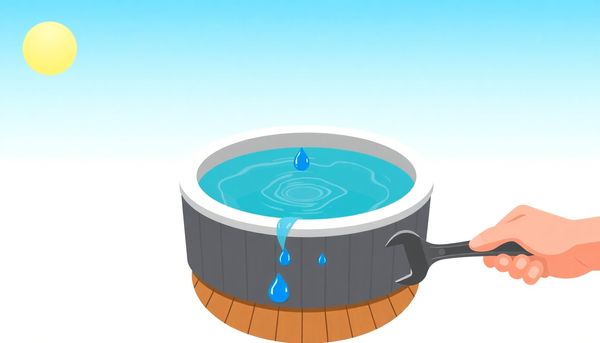
Finding a hot tub leak doesn't need to turn into a saga of endless frustration. A systematic approach can transform what initially seems like a daunting task into an achievable DIY project. Begin your quest by checking the most notorious suspect: the pump. Switch off the power before peeking underneath. If the seal is the issue, a simple replacement might just work wonders. However, if the pump remains dry, shift your focus toward the heating assembly. Components such as the heating element, pressure switch, and sensors are notorious for causing leaks. A little detective work here might save you the cost and hassle of replacing the entire heater.
As you continue your investigation, consider the union fittings. They're known to loosen, so ensuring they're hand-tightened can prevent further leaks. Just be gentle—tools can cause more harm than good here. Don't overlook valves either; knife and ball valves are common culprits. Their gaskets tend to fail over time, and a careful inspection can often reveal a need for replacement.
If all else fails and the leak still eludes you, try the dye test. A few drops of leak-detecting dye or even dark food coloring can reveal the elusive breach, guiding you directly to the problem. And remember, if the leak persists despite your best efforts, it's perfectly reasonable to call in a professional. Sometimes, expertise is the shortcut to getting back to your blissful soak.
A hot tub can transform a chilly evening into a warm retreat, but nothing sours the experience faster than a sneaky leak. One minute, you're enjoying the blissful bubbles, and the next, you're playing detective. To tackle this mystery, begin with the most frequent suspects.
First on the list is the pump area, a notorious leak magnet. Turn off the power for safety, then peek beneath the pump. Water puddles may indicate a failing pump seal. A new seal is usually a simple fix, but if the leak persists, the pump itself might need closer inspection or even replacement.
Heating components also deserve a once-over. The heating assembly, comprising the heating element, pressure switch, and sensors, can spring leaks. Should you spot water here, replacing these parts may be necessary. Remember, if multiple components are dripping, a new heater could be the more efficient choice.
Next, consider the union fittings on the pump and heater. These connections can loosen over time. Tighten them by hand, carefully avoiding tools that might cause damage. A gentle hand is your best ally in this battle.
Finally, investigate the valves and jets. Knife valves, ball valves, and even plastic pipes can all betray you with leaks. A faulty gasket in a jet is often the culprit, and a replacement should remedy the issue. Explore, examine, and eliminate each potential leak, and soon enough, your hot tub will be back in service, offering the relaxation it was meant to.
To tackle the elusive hot tub leak, a colorful approach might just be your best ally: leak-detecting dye. This nifty trick transforms the guesswork into a visual spectacle where water becomes your guide. Simply introduce a bit of this dye—or use an ordinary kitchen staple like dark food coloring—into your hot tub water. As the vibrant hue dances through the currents, watch keenly for the path it takes. The dye will gravitate towards the leak, highlighting the precise spot you might have missed during routine checks.
A friend of mine once faced a stubborn leak that seemed to defy all logic. After hours spent tightening, sealing, and even replacing parts, nothing seemed to stem the flow. Frustration turned into fascination when they used dye—revealing a nearly invisible fissure hidden in a corner of the shell. It was an "aha" moment that made all the difference, saving time and unnecessary expense.
Once the leak's location is pinpointed, you can focus your efforts more effectively. This method not only saves you from dismantling half the tub but also speeds up the entire repair process. So next time you find yourself puzzled by a sneaky hot tub leak, consider this colorful strategy. It might just be the vibrant clue you need in your hunt for aquatic tranquility.
Sometimes, the search for a hot tub leak can feel like hunting for a needle in a haystack. When every DIY attempt turns elusive or complicated, reaching out to a professional might be your best bet. A specialist can identify issues that easily slip past an untrained eye, offering solutions that are both efficient and long-lasting.
You might recall a friend who spent weeks trying to tackle a persistent leak, only to end up with a more complicated issue at hand. By opting for expert assistance, they not only saved time but ultimately reduced costs by preventing further damage. Professionals bring a wealth of experience, often equipped with advanced tools that make diagnosis precise and effective.
Every hot tub has its quirks, and an expert knows where to look—be it a hidden valve or an unforeseen gasket problem. They assess your specific model and situation, ensuring a tailored approach. In some cases, the cost of potential damage from a prolonged leak far outweighs the initial investment in professional help. Plus, having someone knowledgeable on speed dial is a comfort when dealing with the unexpected.
While going solo on repairs can be a rewarding endeavor, sometimes peace of mind is worth the call to a pro. After all, swift, skilled intervention allows you to return to the relaxation your hot tub promises without the worry of further mishaps.
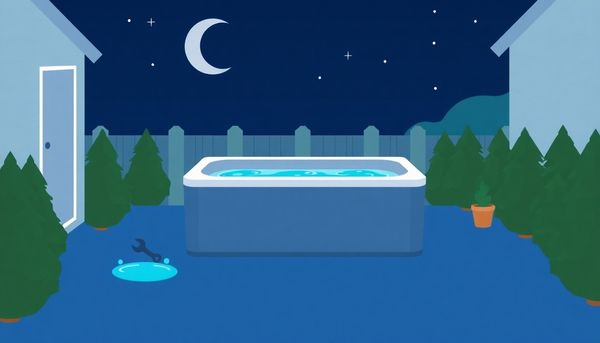
Tracing the origins of a hot tub leak can feel like a detective's quest, with each clue leading you closer to the culprit. Start by examining the pump, as it's often the key suspect in leak investigations. After ensuring the power is off, check beneath it for tell-tale signs of water. If the pump seal is worn, that's a quick fix with a replacement. Should the problem lie deeper within the pump's mechanics, brace yourself for potential repair or replacement.
Next, turn your attention to the heating assembly. Comprising the heating element, pressure switch, sensors, and thermostat, this cluster of components is notorious for developing leaks. A keen eye on these parts might reveal the source of your troubles. Be prepared to swap out any faulty components to restore your tub's tranquility.
Union fittings around the pump and heater are prone to loosening over time. A gentle hand-tightening should suffice here, as wrenches can cause damage. Delve further to inspect knife and ball valves, as their gaskets are frequent failure points.
Don't overlook the jets and plumbing connections. A loose connection can often be remedied with a simple tightening, while a damaged jet gasket might need replacing. For any cracked PVC pipes, consider a plastic repair kit unless replacement is necessary. If the shell itself leaks, a similar repair approach should suffice. These steps, combined with patience and keen observation, will guide you to the solution.
Hot tub ownership often promises relaxation, but nothing quite mars the joy like discovering a leak. Among the usual suspects in this watery mystery are the pump and heater components. These elements are essential but sensitive parts of your hot tub system, and a leak here requires careful inspection and a bit of elbow grease.
Start with the pump, the heart of your hot tub's circulation system. Before anything else, make sure to switch off the power to avoid any electrical mishaps. Next, slide under the pump and check for puddles or moisture. If a leak is evident, the pump seal could be the villain. Replacing it might be the simplest fix, especially if you've got some DIY spirit. On occasions, the entire pump might need attention, possibly calling for a repair or a complete swap if it's beyond saving.
Turn your attention next to the heater, which keeps your water at that perfect temperature. Inspect the entire heating assembly, including the heating element and various sensors. Drips here could mean a part has succumbed to wear and tear. A methodical replacement of faulty components could prevent a larger issue down the line. Look at the union fittings as well, since these can loosen over time. Hand-tightening might be all that's needed, but never use a wrench; that could lead to unnecessary damage.
In my own experience, a loose fitting was all it took to transform my hot tub’s persistent dripping into a steady, calming soak. The solution might be just that straightforward. But if these steps don’t solve the problem, don’t hesitate to consult a professional and reclaim your bubble-filled reprieve.
Once you’ve ruled out the pump and heater as culprits, it's time to turn attention to the valves and fittings, those unseen guardians of your hot tub's inner workings. These components, often overshadowed by more glamorous parts, play a crucial role in maintaining water flow. Over time, though, they can become the unsuspected source of leaks. When inspecting, start with the knife valves, also known as slice or gate valves. These valves, designed to prevent water flow when servicing other components, are notorious for gasket failure. If your gasket is compromised, replacing it could solve the issue.
Next, give ball valves a thorough check. These are typically found near the pump, designed for convenient maintenance without draining the tub. Despite their utility, they’re not invincible; a faulty ball valve can contribute to your leaking woes. Tightening them may suffice, but in some cases, replacement is the only remedy.
Don't overlook the union fittings around the pump and heater. Though they might seem insignificant, their integrity is vital. Hand-tightening these fittings often resolves minor leaks—tools should remain in the toolbox for this task to avoid causing damage.
When dealing with valves and fittings, patience and attention to detail are your best allies. A steady hand and a careful eye can distinguish between a relaxing soak and a soggy nightmare. If uncertainty lingers, or the leak persists, calling a professional remains a wise investment.
Tracing the source of a hot tub leak often leads to the pipes and jets, which can be sneaky culprits in this aquatic conundrum. These components resemble a labyrinth where even the smallest fissure can wreak havoc. A few years back, I found myself in this very predicament—watching water mysteriously vanish, much like socks in a dryer. After ruling out the obvious suspects, I realized the issue lurked within the pipework and jets.
Inspecting these areas requires patience and a keen eye. Begin by examining each pipe for signs of wear or damage. Feel for dampness along the length of the piping, as this often indicates a breach. In my case, a tiny crack was hiding in plain sight, cleverly camouflaged among the shadows of the PVC. A plastic repair kit worked wonders, bonding more robustly than the original material. However, if the damage is extensive, replacing the pipe altogether might save time and future headaches.
Next, turn your attention to the jets. These can loosen or degrade over time, leading to leaks around their seals. A failing gasket might be the villain here. Once again, a quick replacement brought relief and a newfound respect for the small but mighty gasket. Always consult your hot tub's manual or the manufacturer for specific parts to ensure compatibility. Addressing these issues can restore peace and tranquility to your soak, letting you reclaim those long, lazy evenings under the stars.

Amidst the warmth of bubbling water, the last thing one desires is the annoyance of a hot tub leak due to faulty seals and gaskets. These tiny yet crucial components are often overlooked, but they can spell the difference between relaxation and frustration. Seals and gaskets play a pivotal role in maintaining the water-tight integrity of your hot tub. Over time, they can deteriorate, leading to small leaks that might seem deceptively insignificant at first.
Years ago, faced with a similar predicament, I discovered a tiny puddle forming beneath my hot tub. After a bit of detective work, I pinpointed the faulty gasket. With patience and some elbow grease, I managed to replace it myself. Here’s how you can tackle such issues. Begin by inspecting the area around the pump and heater carefully, as these spots are notorious for leaks. If you notice any water seeping around connections, the gasket may be compromised. Replacing a gasket usually requires minimal tools—a screwdriver, a new gasket, and some waterproof lubricant.
When selecting a replacement, ensure it matches the specifications of your hot tub model. A quick call to the manufacturer or a glance at the manual can save time and prevent errors. Once the new gasket is in place, tighten the connection securely, but avoid over-tightening, which can lead to future leaks. This straightforward repair can save significant costs and headaches, allowing you to return to your hot tub sanctuary without delay.
Spotting a leak in your hot tub can often feel like finding a needle in a haystack. Even the smallest crack can lead to significant issues, turning your relaxing oasis into a frustrating mystery. Before despair sets in, remember that with a keen eye and a systematic approach, you can often track down and fix these leaks yourself.
Start by checking the pump housing, where leaks are commonly found. Switch off the power for safety, then inspect beneath the pump for any signs of water. A leaky pump seal is usually the culprit, and replacing it is often a straightforward task. If the seal is intact, the issue may lie with the pump itself, requiring repair or replacement.
Next, examine the heater assembly, a frequent source of leaks due to its various components like the heating element and pressure switch. Inspect each part for moisture accumulation. If multiple components are leaking, it might be time to consider replacing the entire heater.
Don't overlook the union fittings on the pump and heater. These can become loose over time, leading to leaks. Hand-tightening often resolves the issue, as a wrench might cause more harm than good. Also, scrutinize the valves and pipes. Loose connections or faulty gaskets commonly cause leaks, and fixing them is usually just a matter of tightening or replacing the affected parts.
For stubborn leaks, a leak-detecting dye can be invaluable, helping to pinpoint elusive trouble spots. Should all else fail, a professional's expertise might be necessary to restore your hot tub to its former glory.
Replacing faulty components in your hot tub can feel like a daunting task, but with a little patience and guidance, it can be an achievable DIY project. The first step is always identifying the problematic part. Often, worn-out seals or gaskets are the culprits. For instance, if you notice water pooling around the pump area, the seal might have degraded. Swapping out an old seal for a new one usually resolves the issue, restoring the pump’s functionality.
Next, consider the heater assembly. It comprises several parts, including the pressure switch and thermostat, each a potential leak source. Should you detect moisture around these elements, replacing them is necessary. This might seem intricate, yet manufacturers often offer part-specific instructions, simplifying the replacement process.
Valve maintenance is another critical aspect. Over time, knife and ball valves may fail, causing leaks. It's smart to inspect these regularly. When faulty, replacing the valve or its gasket can prevent further water loss. Remember, hand-tightening is key to avoiding damage, especially with union fittings.
Then there are the PVC pipes. Cracks or holes here demand immediate attention. While repair kits offer a temporary fix, replacing damaged pipes guarantees longevity. A tale from a friend springs to mind— a small pipe crack, left unchecked, eventually led to a larger problem. Swift action can prevent such escalations.
Finally, if the problem persists or seems beyond your expertise, consulting a professional ensures a thorough and effective fix, safeguarding your spa experience for the future.
Every hot tub owner dreads the stubborn leak that refuses to be found or fixed. In moments like these, enlisting the expertise of a professional isn't just a luxury—it's often a necessity. These experts, seasoned by years of tackling myriad hot tub issues, can quickly zero in on elusive leaks, saving you both time and frustration.
Remember the last time you attempted a DIY project that seemed deceptively simple? Perhaps it was replacing a faucet or fixing a creaky door. What you thought would take an hour ended up consuming your entire weekend. Hot tub leaks can be similar in their complexity. While some can be resolved with a twist of a wrench or a dab of sealant, others might lurk in less obvious places, demanding specialized tools and technical know-how.
A professional's trained eye can catch what others might overlook—be it a minute crack in the plumbing or a worn-out gasket you thought was fine. Moreover, they come equipped with the right tools, allowing for precise diagnostics and repairs. This can prevent further damage that might arise from an incorrect amateur fix.
Investing in a professional also means peace of mind. Imagine the relief of knowing your hot tub is in capable hands, and before long, you'll be soaking in its warm embrace, rather than worrying about potential water damage or escalating repair costs. In the end, it's about preserving your sanctuary and ensuring every soak is stress-free.
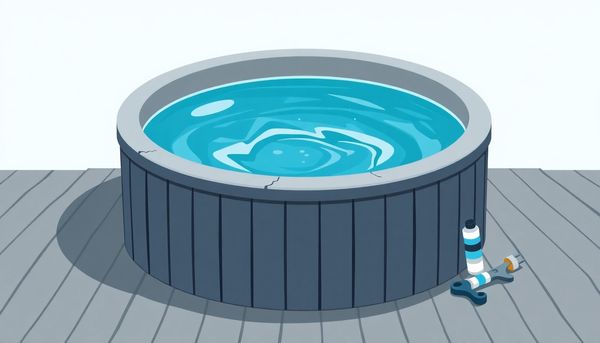
A sudden drip can turn relaxation into exasperation. Among the usual suspects in hot tub leaks are the union fittings, those humble connections that join essential components like the pump and heater. Over time, these fittings can loosen, allowing water to seep out. Luckily, fixing this issue is often straightforward and requires minimal tools—just your own two hands.
A friend once shared a story about his hot tub's persistent puddle problem. After unsuccessfully fussing over more complex parts, he finally inspected the union fittings. Sure enough, a simple hand-tightening banished the leak. Using a wrench might seem tempting for a firmer grip, but it’s a risky move. These components are designed to be tightened by hand only, ensuring you don't inadvertently damage the piping or the equipment itself. This gentle approach helps avoid a cracked fitting or, worse, a significant repair bill.
While you're there, take a moment to check all nearby fittings. Ensuring each one is snug can prevent future leaks. If you notice any persistent wetness even after checking the fittings, examine the surrounding seals and gaskets for wear and tear. Sometimes, it's the smallest adjustments that make all the difference, allowing you to return to a perfectly running hot tub and uninterrupted relaxation.
A hot tub, a sanctuary of warmth and relaxation, can quickly turn into a watery headache when leaks spring up in unexpected places. One often-overlooked culprit lies in the pump and heater fittings. These fittings, while small, play a crucial role in keeping your hot tub from turning into a mini waterfall. An inspection of these fittings can often reveal the source of the leak, saving you from the inconvenience of a soggy backyard.
Start with the union fittings connected to the pump and heater. Over time, these fittings may loosen, thanks to the constant vibrations and water pressure. A simple hand-tightening exercise might be all it takes to fix the issue. However, resist the temptation to use a wrench; these fittings aren’t built for such force and could crack under pressure.
Next, examine the rubber seals, which tend to wear out with age and exposure to chemicals. Cracks or brittleness in the seals are a tell-tale sign they need replacing. Having a spare set of seals on hand can expedite this process, ensuring your hot tub is back in service quickly.
If the fittings and seals seem intact, move on to checking the connections for any signs of corrosion or wear. A visual inspection might reveal rust or mineral buildup, indicating a compromised seal. Regular maintenance, such as cleaning these components, can prevent future leaks and keep your soaking sessions worry-free. By giving these small but vital parts the attention they deserve, you not only prevent leaks but also extend the life and enjoyment of your hot tub.
It’s a peaceful evening, and you're eager to unwind in your hot tub. But there it is—a pesky puddle suggesting a leak. Often, the culprits are loose union connections, pivotal components linking pipes and equipment. Over time, vibrations and temperature changes can cause these fittings to loosen, allowing precious water to escape.
Begin by powering down your hot tub for safety. Once everything’s off, locate the union fittings around your pump and heater. With a keen eye, inspect them for signs of moisture or visible gaps. Gently run your fingers along the connections, feeling for dampness. If you detect a leak, resist the temptation to reach for a wrench. Hand tightening is your best friend here. Excessive force can crack the fittings or damage the attached components, leading to more complicated repairs.
A personal tip: while hand tightening, turn the fitting until you feel firm resistance, then give it a slight, snug twist. This approach has saved me more than once from those dreaded leaks. If the connection still drips after tightening, it might be time to replace the O-ring inside the fitting—a small part but one that’s instrumental in sealing connections.
Once you’ve ensured all the unions are secure, power your tub back on and keep an eye on those connections for a few hours. This simple diligence can restore your hot tub’s integrity, allowing you to finally enjoy that well-deserved soak.
Ever notice how easily a valve can loosen and cause trouble? A simple twist of the hand could be the hero in your hot tub saga. Union fittings, those innocuous connectors between the pump and the heater, often fall victim to time and vibration, gradually slackening until they drip-drop an unwelcome surprise. Before grabbing the nearest wrench in frustration, remember that a gentle hand-tightening could be your best ally.
How does this work in real life? Imagine you've just discovered a persistent puddle under your hot tub. You're stuck between a rock and a hard place, thinking about the potential costs of calling in the pros. Instead, you squat down, locate the union fittings, and apply just enough pressure with your bare hand to secure them. It's an empowering moment, reminiscent of fixing a bike chain or tightening a loose screw. There's a satisfaction in knowing that, with minimal effort and zero cost, you've managed to potentially save yourself hundreds of dollars in repairs.
This approach requires no special tools, just a keen eye and a bit of elbow grease. While not every leak will be solved with a manual twist, tackling those fittings by hand is a straightforward first step that can often resolve the issue without further ado. Next time, when troubleshooting a dripping spa, remember the power of a simple hand-tighten.
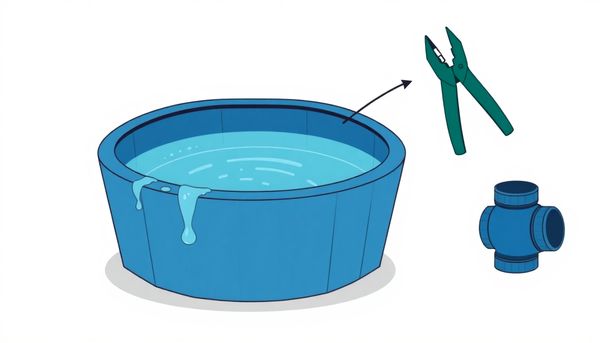
When dealing with a hot tub leak, one often overlooked area is the heating assembly. This vital component can be the source of sneaky leaks, capable of turning relaxation into frustration. Start by turning off the power to prevent any accidents, then venture to the heart of the heating system. It comprises various elements such as the heating element, thermostat, pressure switch, and sensors. Each piece plays its part in ensuring the water remains invitingly warm.
It's useful to know that leaks in the heating assembly often originate from loose fittings or worn-out seals. Imagine spotting a small puddle forming under the heater; this often indicates a leak you can address with a keen eye and steady hand. Give each union fitting a gentle twist to ensure it's snug, remembering that too much force can crack delicate parts.
In some situations, you might notice moisture around the pressure switch or temperature sensors, which suggests the need for new seals or replacements altogether. I once replaced a friend's faulty thermostat and watched their hot tub come back to life, saving them a pricey service call. Should multiple components seem compromised, it may signify the end of the line for the heater itself. In such cases, investing in a new heater might be the prudent choice, promising warmth and peace of mind for future soaks.
Spotting a leak in your beloved hot tub can feel like finding a needle in a haystack. Yet, armed with a bit of patience and some know-how, you can pinpoint those troublesome spots without the need for an expert—saving both time and money. Begin by examining the pump, a notorious leaker. Before diving in, ensure the power is off. Identifying a wet area under the pump often directs you to a faulty seal, which can be easily swapped out for a new one. If the seal looks fine, you might have to consider the pump itself for repairs or replacement.
After inspecting the pump, turn your attention to the heater assembly. Components such as the heating element and pressure switch are frequent culprits. A keen eye can spot where moisture escapes, indicating which part may need replacing. Union fittings, which connect pipes to the pump and heater, deserve a thorough check too. These connectors can loosen over time, and tightening them by hand (never with a wrench) might solve your problem.
If valves pique your curiosity, give them a closer look. Knife valves, ball valves, and similar components can wear out, with gaskets often failing first. A simple gasket replacement often resolves the issue. In your quest, you might also discover leaks from jets or PVC pipes. For these, replacing gaskets or using a plastic repair kit can be your best bet. With these measures, you'll likely find the source of the leak and restore your hot tub to its former glory.
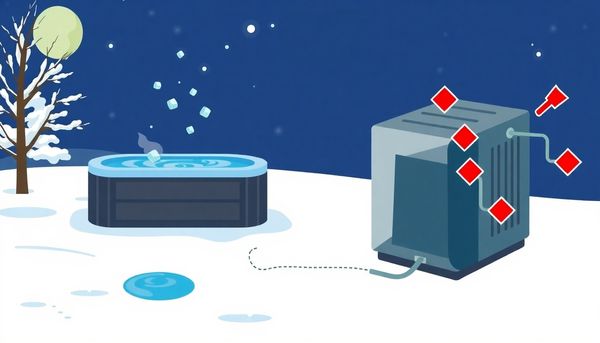
A small drip escaping the confines of your beloved hot tub can be maddening. The source of such leaks can be elusive, but there's a clever trick that can help: using a leak-detecting dye. This technique turns a guessing game into a more precise investigation. Simply introduce the dye into the water and observe its path with care. The colored trail will gravitate towards the breach, pinpointing the troublesome spot without much ambiguity.
Years ago, when my cousin faced a similar predicament, she confided in me her frustration. Her hot tub seemed to mock her with disappearing water levels, yet no visible clues. Then came the suggestion of using dye — a simple yet ingenious method. Much to her relief, she watched the dye snake its way to a small crack near a jet, a detail she had overlooked in her initial scrutiny.
Additions like food coloring can also suffice if specialized dye isn't on hand, making this a practical option for many. It's a method that not only saves time but can also spare the wallet from unnecessary repairs. Once the dye has done its job, you can focus your repair efforts on the exact location, be it a fitting, gasket, or valve issue. This simple solution can be a game-changer, turning a daunting task into a straightforward repair mission.
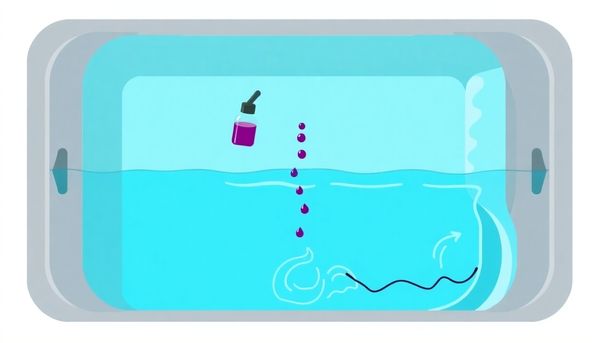
This article provided insights into maintaining your pool. Start your pool care journey today!
Want to become a pool maintenance expert? Our free Pool School course covers everything you need to know about pool care. From basic maintenance to advanced troubleshooting, you'll learn how to:
Join over 10,000 pool owners who have already transformed their pool care routine. Get started with our free Pool School course today!